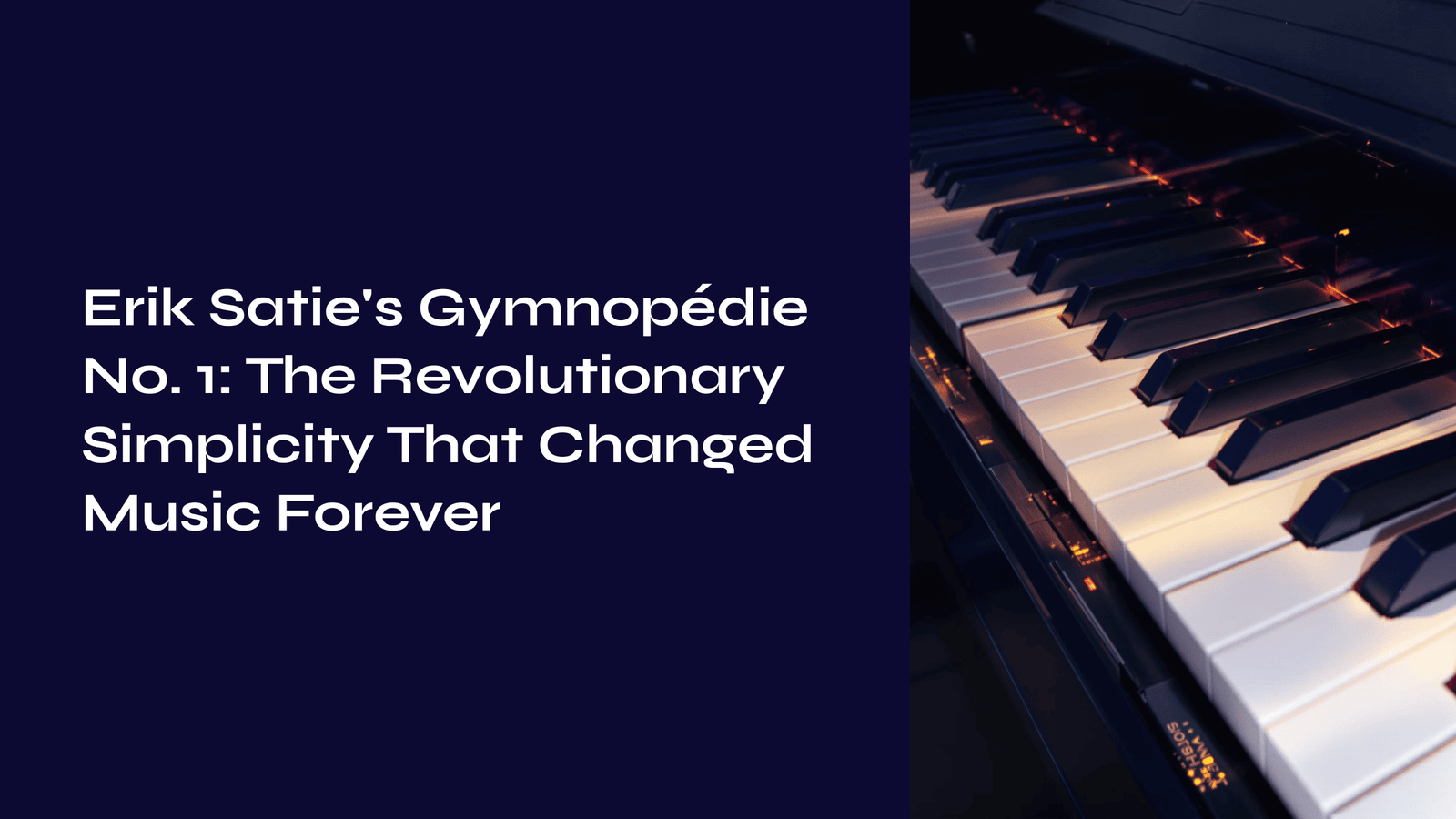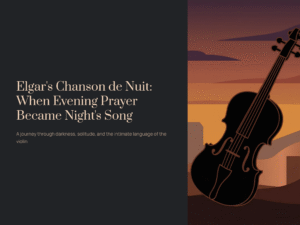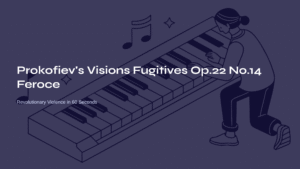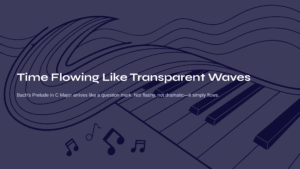Table of Contents

When Less Became More: A Musical Revolution in Three Minutes
There’s something almost magical about hearing those first few notes drift through the air – a simple melody floating over gentle, swaying chords that seem to suspend time itself. It’s the kind of music that makes you pause whatever you’re doing and just listen, as if the world has suddenly slowed down to match its contemplative pace. This is the power of Erik Satie’s Gymnopédie No. 1, a piece that sounds deceptively simple but carries within it the seeds of a musical revolution that would echo through the next century and beyond.
What makes this three-and-a-half-minute piano piece so extraordinary isn’t what it includes, but what it deliberately leaves out. In an era when composers were competing to create the most elaborate, emotionally overwhelming music possible, Satie did something radical: he stripped everything away and found beauty in emptiness, creating what we might now recognize as the first piece of ambient music.

The Rebel Who Rewrote the Rules
Erik Satie wasn’t your typical conservatory-trained composer. Born in 1866 in the Norman port town of Honfleur, he was something of an artistic outsider from the very beginning. After dropping out of the Paris Conservatory twice – his professors found him lazy and untalented – Satie found his true home in the bohemian cabarets of Montmartre, playing piano at Le Chat Noir and Le Lapin Agile to make ends meet.
This unconventional background proved to be his greatest asset. While his contemporaries were buried in academic traditions, Satie was absorbing the raw, unpretentious energy of Parisian nightlife. He was writing music for real people in real spaces, not for concert halls filled with cultural elites. This experience taught him something that would become central to his artistic philosophy: music didn’t need to be complicated to be profound.
When Satie composed the three Gymnopédies in 1888, France was still reeling from its defeat in the Franco-Prussian War and the loss of Alsace-Lorraine. There was a cultural movement to break free from German musical influence, particularly the heavy, emotionally saturated style of late Romanticism. Satie’s response was characteristically contrarian – instead of fighting fire with fire, he chose water: fluid, transparent, and refreshingly clear.

Deconstructing a Masterpiece: The Anatomy of Simplicity
At first glance, Gymnopédie No. 1 seems almost too simple to analyze. Written in D major with a gentle 3/4 time signature, it unfolds at a leisurely 73 beats per minute – about the pace of a slow walk or deep breathing. But this apparent simplicity masks a sophisticated understanding of how music can create emotional space.
The piece opens with something revolutionary for its time: four measures of just two chords alternating back and forth – Gmaj7 and Dmaj7. These aren’t the dramatic, tension-filled harmonies that dominated Romantic music; they’re open, floating, almost weightless. The F# in the upper register acts as a pedal point, creating that characteristic “hovering” sensation that makes the music feel suspended in air.
The melody itself is a study in elegant restraint. Built from quarter notes that rise and fall like gentle waves, it follows the D major scale but never feels predictable. Satie has a genius for making simple stepwise motion feel both inevitable and surprising. The melody breathes with natural phrasing, never rushing, never forcing emotion – it simply exists, like a stream flowing over stones.
What’s truly remarkable is how Satie handles harmonic color. Around measures 16-25, he introduces subtle shifts toward D minor and A minor, creating fleeting shadows that deepen the emotional palette without disturbing the overall tranquility. These moments of harmonic ambiguity were radical for their time – they create a sense of floating between keys rather than being anchored in one.

The Mystery of the Title: Ancient Rituals and Modern Art
The word “Gymnopédie” carries an air of mystery that has fascinated listeners for over a century. The most widely accepted explanation traces it back to ancient Greek “gymnopaedia” – a festival held annually in Sparta where naked male citizens of all ages performed war dances and choral songs to honor Apollo and strengthen Spartan cultural identity.
There’s something beautifully paradoxical about Satie choosing this title for such a peaceful piece. The ancient Spartan festival was about physical vigor, martial prowess, and civic duty – everything that Satie’s music seems to reject. Perhaps this was intentional, a gentle mockery of the grandiose titles that were fashionable in his era. Or maybe he saw something deeper: the idea of stripping away unnecessary elements to reveal essential truth.
Some scholars suggest the title came from Gustave Flaubert’s novel “Salammbô” or from contemporary poetry by J.P. Contamine de Latour. Whatever its exact origin, the name perfectly captures the piece’s essence – something ancient and ritualistic, yet completely stripped of pretense.

A Personal Journey Through Musical Meditation
Listening to Gymnopédie No. 1 is like entering a state of musical meditation. The first time you hear it – really hear it – you might find yourself surprised by your own reaction. In a world of constant stimulation and perpetual motion, this music offers something increasingly rare: permission to be still.
The piece doesn’t demand your attention the way a Beethoven symphony does. Instead, it invites you to float alongside it, to let your mind wander while the music provides a gentle current. It’s the kind of piece that can transform a room’s atmosphere, making mundane spaces feel contemplative and sacred.
What strikes me most about this music is its emotional honesty. Satie marked it “Lent et douloureux” (slow and painful), but the pain isn’t dramatic or self-pitying. It’s the quiet ache of existence itself – the melancholy that comes from being fully present in a world that’s both beautiful and impermanent. This isn’t the cosmic anguish of late Romantic composers; it’s something more intimate and universal.

How to Listen: Unlocking the Secrets of Minimalist Beauty
To truly appreciate Gymnopédie No. 1, you need to adjust your listening expectations. This isn’t music that tells a story or takes you on an emotional journey in the traditional sense. Instead, it creates a sonic environment that you inhabit rather than observe.
Try listening to it in different settings and times of day. Early morning, when the world is still quiet, seems to be its natural habitat. Late at night, it can feel like a lullaby for insomniacs. In a busy café, it becomes a pocket of calm in the chaos. The piece adapts to your mood and surroundings while maintaining its essential character.
Pay attention to the spaces between the notes – the silence is as important as the sound. Notice how Satie uses pedal points to create that floating sensation, how the melody never quite lands where you expect it to. Listen for the subtle dynamic changes that give the piece its breathing quality.
Most importantly, don’t try to analyze it too much while you’re listening. Let it wash over you. This is music designed for contemplation, not dissection. The analysis can come later – first, just experience it.

The Debussy Connection: When Friendship Launched a Revolution
One of the most beautiful aspects of Gymnopédie No. 1’s story is how it was championed by Claude Debussy. In 1896, when Satie’s career was struggling and his finances were dire, Debussy heard his friend playing these “waltz-like” pieces and was immediately captivated. He decided to orchestrate the first and third Gymnopédies (finding the second unsuitable for orchestra), switching their order in the process.
Debussy’s orchestral versions, published in 1898, brought the Gymnopédies to a much wider audience and helped establish their place in the classical repertoire. It’s a perfect example of artistic friendship – one genius recognizing and nurturing the work of another. Debussy’s lush orchestral colors expanded Satie’s transparent piano textures while preserving their essential simplicity and contemplative character.
This collaboration also demonstrates how revolutionary ideas often need time to find their audience. The Gymnopédies weren’t immediately successful – it took about twenty years for the avant-garde to become more accepted in art and music. Sometimes the most important art is ahead of its time.

The Seeds of Tomorrow: How Satie Invented the Future
It’s impossible to overstate how influential Gymnopédie No. 1 has been on the development of modern music. Satie essentially invented ambient music seventy years before Brian Eno coined the term. He created minimalism before Steve Reich and Philip Glass were born. He showed that repetition could be meditative rather than boring, that simplicity could be profound rather than simplistic.
John Cage, one of the most important experimental composers of the 20th century, was deeply influenced by Satie’s approach to time, space, and repetition. The floating structures and endless repetitions in the Gymnopédies provided a blueprint for much of what we now call contemporary classical music.
The influence extends far beyond the concert hall. Jazz musicians, new age artists, electronic producers, and film composers have all drawn inspiration from Satie’s revolutionary approach to musical time and space. Every time you hear music designed to create atmosphere rather than demand attention, you’re experiencing Satie’s legacy.

A Lasting Legacy of Revolutionary Quiet
Erik Satie’s Gymnopédie No. 1 proves that the most radical thing an artist can do is sometimes the simplest. In an age of musical excess, Satie chose restraint. In a time of emotional inflation, he offered quiet honesty. Instead of competing with his contemporaries on their terms, he changed the rules of the game entirely.
The piece reminds us that music doesn’t always need to be about drama, development, or destination. Sometimes it can simply be about being present in the moment, about creating a space for reflection and contemplation. In our current age of constant digital stimulation, this message feels more relevant than ever.
When those first gentle notes begin to float through the air, they’re not just playing a piece of music – they’re opening a door to a different way of experiencing sound, time, and consciousness itself. That’s the true revolution of Gymnopédie No. 1: it doesn’t just change how we hear music; it changes how we listen to the world.
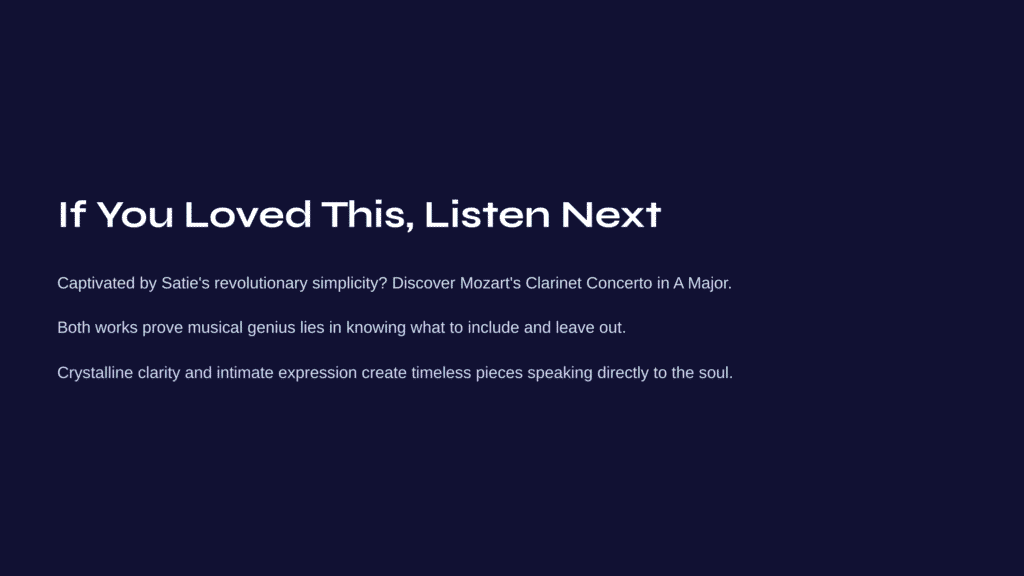
If You Loved This, Listen to This Next
If you were captivated by Erik Satie’s revolutionary approach to simplicity and his ability to create profound emotional depth through restraint, you might find yourself equally enchanted by Mozart’s Clarinet Concerto in A Major: A Journey Through His Final Masterpiece – where similar qualities of crystalline clarity and intimate expression combine to create one of classical music’s most moving statements about beauty found in perfect balance.
Both works demonstrate how true musical genius lies not in complexity, but in knowing exactly what to include and what to leave out, creating timeless pieces that speak directly to the human soul.
